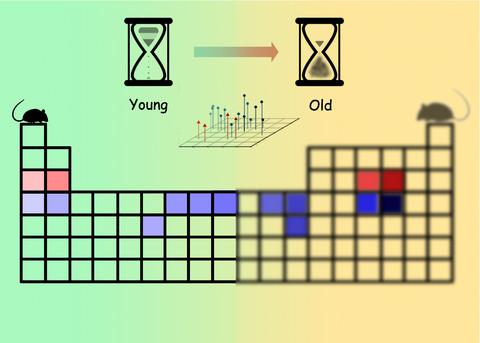当前位置:
X-MOL 学术
›
Aging Cell
›
论文详情
Our official English website, www.x-mol.net, welcomes your
feedback! (Note: you will need to create a separate account there.)
Systematic age-, organ-, and diet-associated ionome remodeling and the development of ionomic aging clocks.
Aging Cell ( IF 8.0 ) Pub Date : 2020-04-23 , DOI: 10.1111/acel.13119 Bohan Zhang 1 , Dmitriy I Podolskiy 1 , Marco Mariotti 1 , Javier Seravalli 2 , Vadim N Gladyshev 1
Aging Cell ( IF 8.0 ) Pub Date : 2020-04-23 , DOI: 10.1111/acel.13119 Bohan Zhang 1 , Dmitriy I Podolskiy 1 , Marco Mariotti 1 , Javier Seravalli 2 , Vadim N Gladyshev 1
Affiliation

|
Aging involves coordinated yet distinct changes in organs and systems throughout life, including changes in essential trace elements. However, how aging affects tissue element composition (ionome) and how these changes lead to dysfunction and disease remain unclear. Here, we quantified changes in the ionome across eight organs and 16 age groups of mice. This global profiling revealed novel interactions between elements at the level of tissue, age, and diet, and allowed us to achieve a broader, organismal view of the aging process. We found that while the entire ionome steadily transitions along the young‐to‐old trajectory, individual organs are characterized by distinct element changes. The ionome of mice on calorie restriction (CR) moved along a similar but shifted trajectory, pointing that at the organismal level this dietary regimen changes metabolism in order to slow down aging. However, in some tissues CR mimicked a younger state of control mice. Even though some elements changed with age differently in different tissues, in general aging was characterized by the reduced levels of elements as well as their increased variance. The dataset we prepared also allowed to develop organ‐specific, ionome‐based markers of aging that could help monitor the rate of aging. In some tissues, these markers reported the lifespan‐extending effect of CR. These aging biomarkers have the potential to become an accessible tool to test the age‐modulating effects of interventions.
中文翻译:

与年龄、器官和饮食相关的系统性离子组重塑和离子组衰老时钟的发展。
衰老涉及整个生命过程中器官和系统协调但独特的变化,包括必需微量元素的变化。然而,衰老如何影响组织元素组成(离子组)以及这些变化如何导致功能障碍和疾病仍不清楚。在这里,我们量化了 8 个器官和 16 个年龄组小鼠的离子组变化。这种全局分析揭示了组织、年龄和饮食水平上各元素之间的新颖相互作用,使我们能够对衰老过程获得更广泛的有机认识。我们发现,虽然整个离子组沿着年轻到年老的轨迹稳定过渡,但各个器官的特征是明显的元素变化。热量限制(CR)小鼠的离子组沿着相似但变化的轨迹移动,表明在有机体水平上,这种饮食方案改变了新陈代谢,以减缓衰老。然而,在某些组织中,CR 模仿了对照小鼠的年轻状态。尽管某些元素在不同组织中随着年龄的增长而变化不同,但一般来说,衰老的特点是元素水平降低及其变异性增加。我们准备的数据集还允许开发器官特异性、基于离子组的衰老标记,有助于监测衰老速度。在一些组织中,这些标记物报告了 CR 的寿命延长作用。这些衰老生物标志物有可能成为测试干预措施的年龄调节效果的可用工具。
更新日期:2020-04-23
中文翻译:

与年龄、器官和饮食相关的系统性离子组重塑和离子组衰老时钟的发展。
衰老涉及整个生命过程中器官和系统协调但独特的变化,包括必需微量元素的变化。然而,衰老如何影响组织元素组成(离子组)以及这些变化如何导致功能障碍和疾病仍不清楚。在这里,我们量化了 8 个器官和 16 个年龄组小鼠的离子组变化。这种全局分析揭示了组织、年龄和饮食水平上各元素之间的新颖相互作用,使我们能够对衰老过程获得更广泛的有机认识。我们发现,虽然整个离子组沿着年轻到年老的轨迹稳定过渡,但各个器官的特征是明显的元素变化。热量限制(CR)小鼠的离子组沿着相似但变化的轨迹移动,表明在有机体水平上,这种饮食方案改变了新陈代谢,以减缓衰老。然而,在某些组织中,CR 模仿了对照小鼠的年轻状态。尽管某些元素在不同组织中随着年龄的增长而变化不同,但一般来说,衰老的特点是元素水平降低及其变异性增加。我们准备的数据集还允许开发器官特异性、基于离子组的衰老标记,有助于监测衰老速度。在一些组织中,这些标记物报告了 CR 的寿命延长作用。这些衰老生物标志物有可能成为测试干预措施的年龄调节效果的可用工具。











































 京公网安备 11010802027423号
京公网安备 11010802027423号